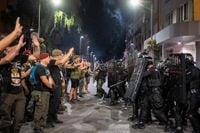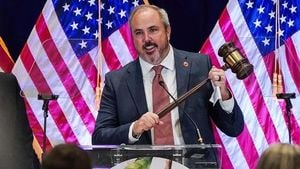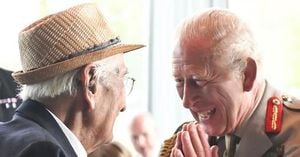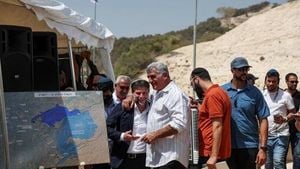Serbia is in the throes of its most turbulent political crisis in over a decade, as anti-government protests have rocked the country for five consecutive nights, culminating in fiery clashes, mass demonstrations, and a standoff between President Aleksandar Vučić and an increasingly emboldened opposition. The unrest, which began as a response to a deadly infrastructure disaster, has metamorphosed into a nationwide outcry against corruption, authoritarianism, and the perceived erosion of democratic norms.
The spark that ignited this movement was the tragic collapse of a railway station canopy in Novi Sad last November, which claimed the lives of 16 people. According to reporting from The Globe and Mail and other outlets, many Serbians blamed the disaster on what they saw as endemic corruption and corner-cutting in state-run infrastructure projects. As grief gave way to anger, peaceful protests began to swell, with hundreds of thousands demanding accountability, early elections, and sweeping systemic reforms.
But the mood on the streets shifted dramatically this past week. On August 16, masked protesters in the western city of Valjevo set fire to the offices of President Vučić’s ruling Serbian Progressive Party (SNS), a move that escalated tensions to a fever pitch. Riot police responded with tear gas and stun grenades, and soon, similar scenes played out in the capital Belgrade and the northern city of Novi Sad. Unverified footage circulated widely on social media appeared to show police officers beating a man—an image that further inflamed public outrage and prompted fresh allegations of police brutality. Serbia’s interior ministry, however, has denied these accusations.
As the unrest spread, the protests began targeting not just the SNS but also the Serbian Radical Party, a coalition partner, with demonstrators smashing windows and defacing party symbols. The movement’s demands have grown louder and more urgent, with calls for early elections and the release of those detained during the clashes. On August 17, thousands defied the government’s threat of a crackdown and marched through towns and cities across Serbia, chanting “Arrest Vučić” and insisting that all detained protesters be freed. Notably, Sunday’s demonstrations unfolded without new incidents, but the sense of volatility remains palpable.
President Vučić, whose 12-year rule has been marked by both economic growth and mounting criticism of democratic backsliding, has responded with a mix of defiance and stern warnings. In a series of public statements, including a televised address and a post on Instagram, he dismissed the protests as a “foreign-backed attempt to unseat him” and described the unrest as “an expression of total weakness.” He vowed to “punish the bullies” and restore order, but stopped short of declaring a state of emergency. “You will witness the determination of the state of Serbia,” Vučić declared, promising that “we will use everything at our disposal to restore peace and order in the country.”
In his most forceful rhetoric yet, Vučić accused the demonstrators of “pure terrorism” and claimed, without offering concrete evidence, that the protests were orchestrated by Western powers intent on destroying Serbia. “Our country is in grave danger, they have jeopardized all our values, normal life, each individual,” he said, warning that without tougher measures, “it is a question of days when they (protesters) will kill someone.” He characterized the opposition as seeking to install “anarcho-leftist” authorities, a charge that has resonated with some of his supporters but has further polarized the national mood.
International reaction has been swift and concerned. Michael O’Flaherty, the Council of Europe’s human rights commissioner, condemned what he described as the police’s “disproportionate force” and urged Serbian authorities to halt arbitrary arrests and work to de-escalate the situation. The unrest has also drawn attention from Serbia’s powerful allies. Russia, a longstanding partner with deep cultural and political ties to Belgrade, has thrown its weight behind Vučić. Moscow’s Foreign Ministry issued a statement defending the Serbian police’s “lawful methods” to contain what it called “violent mobs,” and Vučić himself publicly thanked Russia for its backing against what he labeled a “colored revolution.”
All of this has unfolded against the backdrop of Serbia’s ongoing bid for European Union membership. While the government has formally pursued EU accession, Vučić has maintained strong ties with both Russia and China—an approach that has sometimes put him at odds with Western expectations regarding democratic governance and rule of law. Critics, both domestic and international, have accused Vučić of stifling democratic freedoms and allowing organized crime and corruption to fester, charges he has repeatedly denied.
For many ordinary Serbians, the past week has been a jarring escalation of a crisis that had, until recently, played out in a mostly peaceful fashion. The initial demonstrations, rooted in grief over the Novi Sad tragedy, have grown into a broader reckoning with the direction of the country. Protesters have accused the government of negligence, corruption, and authoritarianism, while the authorities have painted the opposition as dangerous radicals bent on chaos. The government’s response—marked by mass detentions, allegations of excessive force, and threats of even harsher measures—has only deepened the sense of uncertainty about what comes next.
Despite the president’s assurances that “a state of emergency is not imminent,” the atmosphere in Serbia remains tense. The ruling party’s offices have become frequent targets, and the opposition shows no sign of backing down. With both sides digging in and international scrutiny intensifying, the country appears braced for a prolonged period of volatility. The protests now represent the most significant challenge to Vučić’s rule since he came to power, and the outcome may well shape Serbia’s political landscape for years to come.
As the world watches, Serbians are left to grapple with difficult questions about accountability, democracy, and the future of their country—a future that, for now, hangs in the balance.




